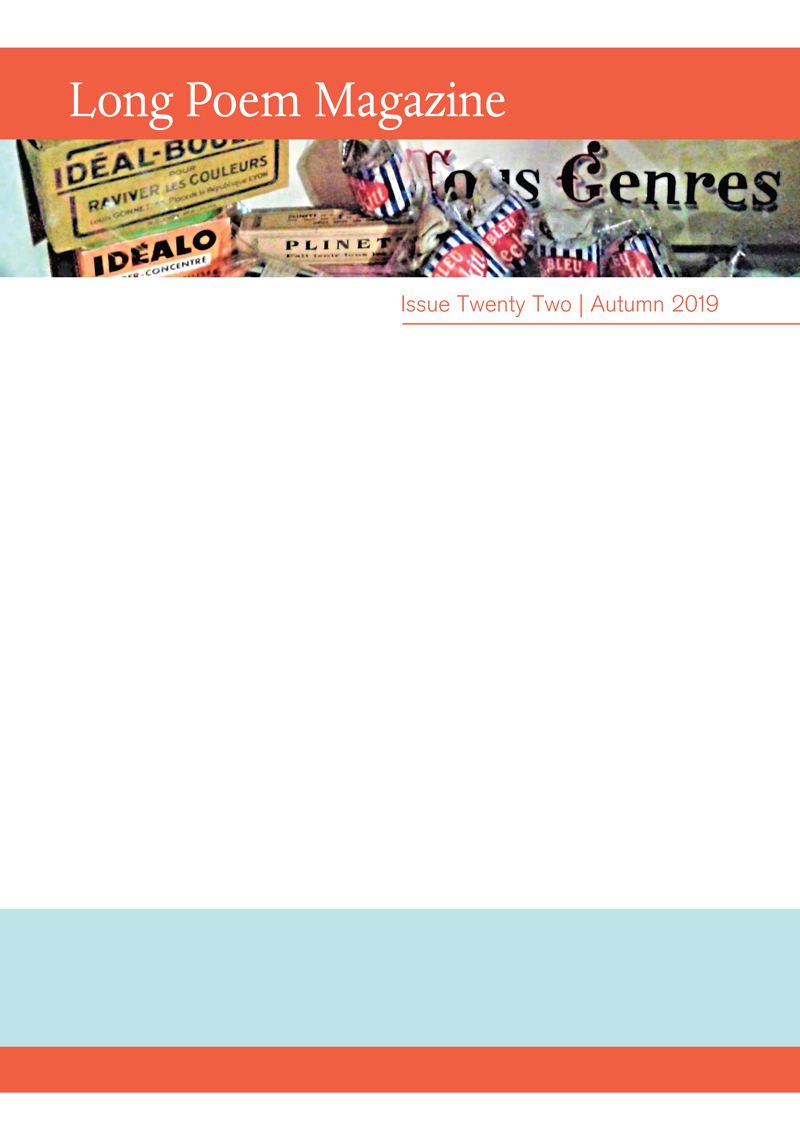Long poems nudge their writers further and further – through research, recollection, and personal discoveries. Poets who embrace this are rewarded with fresh and memorable poems. That’s why Long Poem Magazine has always placed a short piece on the poets’ process at the front of each poem. This introduction is not intended to outline the background history of a poem’s contents – though there will often be some of that. Our distinctive introductions tell how each long poem and poet are on an exciting and arduous journey. Readers understand, when you read these introductions, that a long poem is the view from a mountaintop. We look for such breath-takers when we read through the submissions. The views that roll out a new territory, the poems that silence us as we read, are certain to be poems whose process is equally fascinating.
Ian Duhig, for example, says in his introduction to ‘Machines’, ‘[Sound artist Ryoko Akama] was creating devices making light and music from obsolete mill machinery and when I mentioned Poverty Poverty Knock, a song of industrial strife set to the rhythm of an old weaving machine, she suggested incorporating these rhythms into my text.’ We did not know this when we first read the poem, nor did we need to know to enjoy it. But it adds to the depth of reader appreciation.
Julith Jedamus describes her extraordinary path through the poetry of pain in ‘Field Hospital’: ‘I developed a rare nerve condition that is difficult to diagnose and impossible to cure. During the months when I was confined to my home in West London, I wrote a series of poems to help see me through this difficult period. Many were about flowers; the others were about pain. Over time, the flower-poems began to bleed into the pain-poems, and vice-versa.’ Building from many parts, slowly integrating those parts, is a common method for constructing the longer poem. We are often asked if a sequence is classed as a long poem. Indeed ‘Field Hospital’ shows it can be.
In ‘Hannah’, a poem by David Sollors addressing a fatal rail accident, the introduction is a concise revelation of how engineering a poem flows with a poet’s feelings: ‘My short threnody became a scheme of 16 poems, each of 12 lines. Later, I descended by cage into mines, read books, statutes, Lt Col Druitt (RE)’s analysis of the disaster and found other graves. Drafts were mapped, prepared, edited, rejected, consolidated, and in this evolution my lines and the lives of the dead intersected. A decade on it was clear that my original structure was too rigid; death and life are too fluid; lives, ours and those of a century ago, too interlinked.’
Introductions can be startling as in Jee Leong Koh’s brilliant satire, ‘Snow At 5 Pm: Translations Of An Insignificant Japanese Poet’. The process of translation described is that of the imagined translator, also named Jee Leong Koh, and so the introduction is part of the poem itself, written by Koh’s imagined translator and describing the haiku that he had found charred in a fireplace: ‘The manuscript had a title ぐらつく, or ‘Unsettled’, which has been crossed out firmly with three pencil strokes. I take the deletion as the author’s intention, and so I have given this book a title by quoting the last line of the last haiku.’ The poem is a witty tour de force and Jee Leong Koh’s own process remains hidden from the reader.
We hope these introductions, every one with its individual fascination, will call you into the poems in this issue. Thanks again to our poets who have shared their techniques with all of us.
Claire Crowther, November 2019
